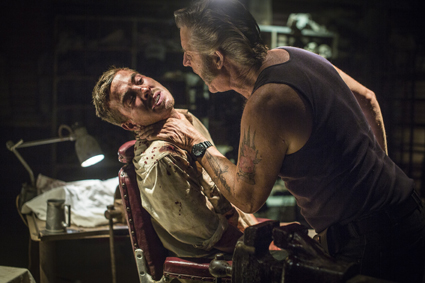Whose side are you on?
Katerina Sakkas: Wolf Creek 2

Wolf Creek 2
When considering empathy in relation to horror films, it’s worth asking the question, “Whose side are you on?” How, in other words, do filmmakers position the audience vis-a-vis monster and victim? Greg McLean’s outback nightmare Wolf Creek and its sequel Wolf Creek 2 form a good basis for such a discussion, presenting as they do two sides of the same horror coin.
Wolf Creek (2005) is possibly Australia’s best and most brutal horror film. In her analysis of the film for the Australian Screen Classics series (Currency Press, 2011; review RT 108, p20) Sonya Hartnett highlights the way Wolf Creek undercuts an audience’s expected response to a horror movie—”the thrill of being terrified from a safe distance”—through its conscious association with real events. She goes on to question whether Wolf Creek is for this reason a bona fide horror film, or “simply a movie which depicts something ghastly?” While it’s not uncommon for horror filmmakers to signal their work as “based on actual events,” Wolf Creek references the backpacker murders in NSW in the 1990s and the Peter Falconio disappearance in 2001 with such conviction as to ally it more with a film such as Snowtown (2011) than, say, Friday the 13th (1980).
Playing upon various pressure points within non-indigenous Australian culture—fear of the bush, with its attendant lost child narratives (see Picnic at Hanging Rock and One Night the Moon) and the emblematic figures of the lone bushman and larrikin ocker—the film forces the viewer into a space of such chilling verisimilitude that there is no option but to side with the hunted.
Wolf Creek 2 (2013), while virtually mirroring its predecessor in subject matter, is markedly different in treatment. It comes across as a comic book version of the first film, with brighter colours, plentiful gags, seat-of-the-pants car chases, huge trucks and explosions. It’s a much more conventional slasher, a textbook illustration of Linda Badley’s description in Film, Horror and the Body Fantastic of a sub-genre that “came to rely almost solely on suspense based in the assurance that the next scene (or sequel) would be graphically violent or fantastically gruesome” (Badley, Greenwood, 1995). And so it goes that the terrifying credibility of the first film is blasted away in an eruption of splashy effects where the bogeyman becomes a crude caricature with his primary victim (unconventionally male, it must be noted) remarkably resilient and somewhat implausibly quick-witted.
The question of identification, of “Whose side are you on?”, is a confusing one in Wolf Creek 2, specifically in relation to the murderous Mick Taylor (John Jarratt). The opening scene has two bored, bent cops attempting to set Mick up for speeding. It’s a moment of persecution that positions Mick, momentarily at least, as the object of police victimisation, cementing an impression of him as anti-establishment folk figure. A raft of cheesy one-liners reinforce this as the film progresses. Conversely, however, Mick is also Ugly Australia writ large, spitting diatribes about “foreign vermin” in relation to his tourist victims: “All them bodies. They deserved it. Foreign bastards. Noxious bloody weeds. Somebody’s gotta keep Australia beautiful.” The grotesque “Aussie history quiz” that Mick puts his English prisoner though parodies the infamous citizenship test introduced by the Howard Government in 2007, with its questions about the first year of white settlement and Don Bradman.
With this political reference, McLean seems to be making a larger point about the Australian hostility to outsiders which finds its current incarnation in asylum seeker policy. But does Mick’s xenophobic schtick engender empathy or even sympathy for Mick’s victims—and by extension, perhaps, the asylum seekers who are denied entry to Australia? I’m not so sure.
Towards the end of her book on Wolf Creek, Hartnett speaks of the problematic nature of the text that appears at the end of the film suggesting the events depicted actually occurred (in contrast to the less specific “based on actual events” at the film’s beginning). It’s a feature that’s repeated in Wolf Creek 2. Hartnett argues, with justification, that such a tactic “seems to detract from the truth of those who really did endure those events on which the film is based…It feels like a cheapening of their story to force fictional characters among them and claim that those suffered too.” When viewed in light of the sequel’s farcical approach, such a ploy for believability seems doubly misplaced. The probably intentional resemblance of the young German couple in the film to Ivan Milat’s victims Gabor Neugerbauer and Anja Habschied introduces another layer of dubiousness.
Stylistically, Wolf Creek 2 is a perfectly assured slasher film, a spectacle likely to produce excitement in those new to the genre and numbness in more hardened viewers. What’s lacking is any lasting sense of fear or, empathy, a bit of a problem given the film’s knowing entanglement with very real tragedy.
Wolf Creek 2, director Greg McLean, writers Greg McLean, Aaron Sterns, cinematography Toby Oliver, music Johnny Klimek, Roadshow Films, Australian release February 2014
RealTime issue #120 April-May 2014 pg. 12






